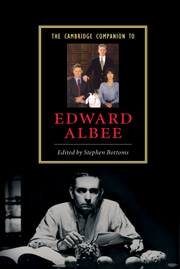Book contents
- Frontmatter
- 1 Introduction
- 2 Albee’s early one-act plays
- 3 Who’s Afraid of Virginia Woolf?
- 4 “Withered age and stale custom”
- 5 Albee’s 3½
- 6 Albee’s threnodies
- 7 Minding the play
- 8 Albee’s monster children
- 9 “Better alert than numb”
- 10 Albee stages Marriage Play
- 11 “Playing the cloud circuit”
- 12 Albee’s The Goat
- 13 “Words; words... They’re such a pleasure.” (An Afterword)
- 14 Borrowed time
- Notes on further reading
- Select bibliography
- Index
- Series List
9 - “Better alert than numb”
Albee since the eighties
Published online by Cambridge University Press: 28 May 2006
- Frontmatter
- 1 Introduction
- 2 Albee’s early one-act plays
- 3 Who’s Afraid of Virginia Woolf?
- 4 “Withered age and stale custom”
- 5 Albee’s 3½
- 6 Albee’s threnodies
- 7 Minding the play
- 8 Albee’s monster children
- 9 “Better alert than numb”
- 10 Albee stages Marriage Play
- 11 “Playing the cloud circuit”
- 12 Albee’s The Goat
- 13 “Words; words... They’re such a pleasure.” (An Afterword)
- 14 Borrowed time
- Notes on further reading
- Select bibliography
- Index
- Series List
Summary
The American theatre can be an unfriendly place. Eugene O'Neill despaired of it producing his last works. Tennessee Williams went out of favor with critics and public alike from 1960 onward, while Arthur Miller found his plays of the 1970s, 1980s, and, to some degree, 1990s rejected. Edward Albee also visited the outer planets of the critical world for several decades, despite picking up a second Pulitzer Prize for Seascape (1975). American lives, it seemed, really did not have second lives, at least as far as American critics were concerned. Then came Three Tall Women (1991) and the sun shone again. Another Pulitzer burnished the gold of his reputation. But Albee had not been silent, merely working out of the limelight - content, if not happy, to continue to write and direct, whether in America or in Europe.
- Type
- Chapter
- Information
- The Cambridge Companion to Edward Albee , pp. 148 - 163Publisher: Cambridge University PressPrint publication year: 2005

